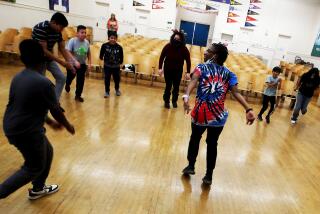Calendar for Year-Round School Use Recommended
- Share via
A Los Angeles Unified School District task force Tuesday recommended that the district adopt a so-called 90/30 calendar for year-round school as a means of relieving overcrowding and eliminating confusion over the schedules for 587,000 students.
The 90/30 calendar divides the school year into two academic terms of roughly 90 days each. It also offers a 10-day winter vacation and two other vacation periods during the year. The schedule will allow a school to serve 33% more students than under a traditional two-semester calendar.
Los Angeles schools have used 90/30 scheduling in the elementary and junior high school levels but not in high schools. The calendar was recommended on a vote of 12 of 16 task force members present. Three voted for another year-round plan. One member abstained, and one was absent.
“The 90/30 calendar represents the best alternative and the best thinking of the task force,” said Charles Dickerson, the group’s chairman. “We understand the various concerns. But after considering all the evidence, 90/30 is the best choice. And therefore, we are going to recommend it.”
The task force, which spent the last three months surveying parents, community members, child-care providers, businesses and public service agencies, will submit a final report to Supt. Leonard Britton on June 30. Although the task force has only an advisory role, its findings could influence future board deliberations on the politically divisive issue.
The school board initially adopted a districtwide year-round plan last year, only to scuttle it after heated internal debate and public outcry. The school board established the 17-member task force in January to examine school calendars and determine if one calendar could be found that would satisfy the diverse needs of the district.
The task force narrowed its options to three calendars. The other two included a five-term calendar, which divides the year into five 45-day blocks. A student would be in class for four terms and off for one.
The third calendar is called Concept 6, which divides students’ schedules differently, depending on which “track” the student is on. A student, for example, could attend class for 40 days, followed by 40 days of vacation. Or a student could be in class for 80 days, and off for 40 days.
All three calendars considered by the task force give all students some time off during winter; two give students a spring break.
District officials argue that a common calendar would eliminate the confusion and inconvenience that currently exists and would encourage parks, camps, child-care providers and other youth-oriented agencies to offer their services on a year-round basis. But critics say the calendars would disrupt family vacations, make child care more difficult and force youngsters to attend classes that were not air-conditioned.
Six different calendars currently are in use in the district’s more than 600 schools. The majority of students attend school on the traditional two-semester, September-to-June calendar. But more than one-fourth of the district’s 587,000 pupils follow one of five different year-round schedules in which school begins in July.
Most year-round calendars have the same number of school days as a traditional calendar but organize the vacations and academic terms differently. Instead of having fall and spring semesters, with a three-month summer break, a student in a year-round school might have, for instance, rotating terms of 60 days in school and 20 days on vacation.
A “multitrack” year-round calendar could be used to increase the capacity of a school by dividing a student body in three groups, only two of which would be using the classrooms at any one time. Many students would be in school during the summer. Most of the district’s approximately 90 year-round schools operate this way because they are overcrowded and cannot build new classrooms fast enough to meet the demand.
More to Read
Sign up for Essential California
The most important California stories and recommendations in your inbox every morning.
You may occasionally receive promotional content from the Los Angeles Times.














